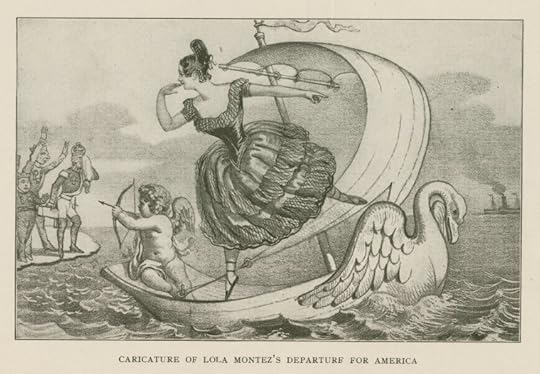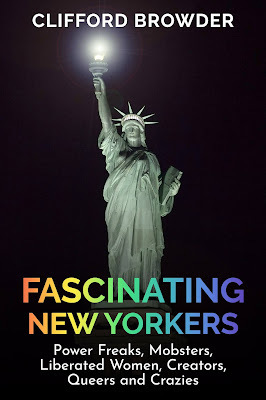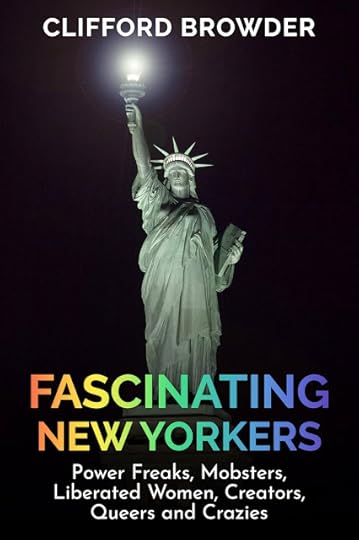Clifford Browder's Blog, page 3
October 10, 2021
529. PR and Old Sigi Freud
PR and Old Sigi Freud
Have you ever felt manipulated, pressured to do something, buy something, vote for someone or something? Have you ever done something on an impulse, and then later wondered why? What probably motivated you has been called “persuasive communication,” but today the term is PR, public relations, and guess who’s to blame: Sigi Freud!
Not that he got directly involved; he remained aloof, the distinguished pioneer in the study of the subconscious mind. It was his Americanized nephew, Edward L. Bernays, who adopted Uncle Sigi’s ideas. Bernays has been hailed … or vilified … as “the father of public relations.”
An example of his handiwork: In the 1920s he had Lucky Strike cigarettes as a client. Their problem: women didn’t smoke. So Bernays went to work, He launched a nationwide survey: “What is your favorite color?” Women answered “green,” the color of nature and money.
So Bernays hired hundreds of beautiful women, all dressed in green and smoking cigarettes, to parade through Paris, London, Milan, and New York. The result: all over the world women began smoking.
And what did he call cigarettes? Torches of freedom. Liberated from Victorian mores, women supposedly showed their independence by smoking — an idea that Big Tobacco would push to the limit.
“You’ve come a long way, baby,” announced the 1970s ads for Virginia Slims cigarettes, made by Philip Morris and marketed specifically to women; I remember them distinctly.
So there you have it: torches of freedom, which some today have rechristened “cancer sticks.” And it’s all thanks, via his nephew, to Uncle Sigi Freud. Who, by the way, was a smoker.
PR was welcomed and used not only by merchandisers, but also by authoritarian movements and regimes determined to tame and control the moods and actions of the mobs of people empowered by democracy.
For that, too, thank you Uncle Sigi, via your brilliant nephew, Mr. Barclays, whom Life magazine once hailed as one of the one hundred most influential Americans of the twentieth century.
Source note: This post was inspired by Bruce Poli’s article, “Sigmund Freud and the Birth of Public Relations,” in the October 2021 issue of WestView News, the monthly local newspaper serving New Yotk’s West Village. Much of its information comes from that source.
© 2021 Clifford Browder

October 3, 2021
528. Nine Reasons Why I Hate Facebook
Nine Reasons Why I Hate Facebook
He created a monster.
Photo credit: Elaine Chan and Priscilla Chan
Why do I hate thee, Facebook, let me tell thee why.
When I go to my Facebook page, I am assaulted by posts from people who may be followers of mine, but whom I don’t know and probably — with a few exceptions — don’t want to know. And their photos appear alongside mine. Off to the right there may be ads that I have no control over, and a list of CONTACTS, some of whom I recognize, and many of whom are total strangers.Among the long string of posts are photos of cats: adorable, but how many photos of adorable cats am I obliged to look at and proclaim love of? Photos of the adorable young children of total strangers evoke the same response.These posts from strangers elicit responses from other total strangers — “Adorable!” “Beautiful!” “So cute!” — making me feel that there are conversations going on that I am not a part of, even though all this is on my page.And if the subject is not adorable pets but something political, the responses are a chorus of exclamations — “I totally agree!” “You are so right!” “Well said!” — showing that the blogger is preaching to the choir. And any disagreement, even if expressed civilly, risks provoking a swarm of nasty outcries and accusations of bigotry, racism, homophobia, cynicism, and misogyny.On the left of the page is a long menu of options, most of which utterly baffle me: Groups, Watch, Memories, Saved, News, plus the ominous threat of STILL MORE.Yes, somewhere over to the right is access to my other page, the “public” one, Browderbooksbiz, as if this, my “private” page, weren’t overrun with an uninvited public. And if I go to Browdebooksbiz, I’m immediately confronted with invitations that will cost me time and money: Create Ad, Create Post, Create New Ad, Boost a Post, Automatic Ads. “Biz,” indeed, but whose “biz” is it? Certainly not mine.In short, Facebook is jumbled, chaotic, time- and money-sucking, irrelevant, and intrusive. Mark Zuckerberg, its co-founder and CEO, has produced a sprawling, hungry monster that devours, or tries to devour, whatever lies in its path. And that means us.And this doesn’t even address such problems as FB’s failure to block Russian interference in our 2016 election, fake news, hate speech, and its syphoning off of personal data without our knowledge or consent. Why then do we still keep our accounts? Several reasons:
Habit, which usually is another word for laziness, for lack of initiative, for blind and timorous conformity.FB reminds us of birthdays, anniversaries, and other events we might otherwise forget.It lets us keep in touch with distant family and friends without the trouble of making phone calls or writing letters — so twentieth-century, so “quaint.”It’s often needed for work or school.If anyone wants to agree or disagree, proclaim undying love for, or unremitting hate of, Facebook, or some wishy-washy position in between, the author welcomes such interventions and would love to hear from you. The monster is in our midst, clutching at our throats. How can we ignore it?© 2021 Clifford Browder
September 26, 2021
527. Polly Adler, Queen of Tarts
Polly Adler, Queen of Tarts
“Going to Polly’s?” was a question often asked among the city’s night-reveling elite in the Roaring Twenties, that fabled decade when Prohibition and the Charleston reigned. But more often one heard “See you at Polly’s,” for the presence there of one’s partying friends could be safely assumed. “Polly’s” was obviously a very “in” place at which to be seen. But what was it, and who was Polly?
Polly’s: 215 West 75th Street, on the West Side of Manhattan. Persian carpets, Louis XV and Louis XVI furniture, gilded mirrors, oil paintings of delicious female nudes, a Gobelin tapestry showing Vulcan and Venus wantonly engaged, and walls lined with books that added atmosphere but seemed rarely to be read. Whoever she was, Polly was in the chips.
And in the evening the place was jammed with people:
Mayor Jimmy Walker and his chorus girl playmate;world heavyweight champion Jack Dempsey;gangsters Lucky Luciano and Dutch Schultz;politicians, actors, judges;and Algonquin Round Table members Dorothy Parker and Robert Benchley.
There were late-evening dinner parties amid the buzz of gossip, while some guests played mah-jongg in a Chinese room, and business deals were struck over a Scotch and soda at the bar.
Presiding over all was Polly, short and dark-haired with a winning smile, no rare beauty but a friend to all. She had come a long way from her humble Jewish origins to become the city’s most notorious and successful madam.
Yes, Polly’s was a brothel, well stocked with young women available at the going rate of twenty dollars a tumble. Some guests came for sex, some for cards and drinks, and some for an atmosphere mixing the elegant and the tacky. But they all came for Polly Adler, Queen of Tarts.
* * * * *
For more about Polly, see chapter 14 of my newly released paperback, Fascinating New Yorkers: Power Freaks, Mobsters, Liberated Women, Creators, Queers and Crazies. Polly was certainly liberated. You will learn
How a nice Jewish girl became a procuress;How, one after another, her houses were raided and shut down, and she went to court in a mink;How charges against her were mysteriously dropped, allowing her to open another even more luxurious establishment;How Polly finally quit the trade, realized a childhood dream by finishing high school, and published a memoir that became a bestseller: A House Is Not a Home.
Though attracted to men, she never married. Marriage had little appeal, compared to being Queen of Tarts.
Polly is just one of many New Yorkers, some remembered and
some forgotten, some sinister, some admirable, and some notorious, who appear in Fascinating New Yorkers. Knowing them, you may
be shocked or puzzled or angered, but you will not bored. The paperback is available from Amazon.
© 2021 Clifford Browder
September 19, 2021
526. Wild Women of the West
Lola Montez
Wild Women of the West
To the American cities of the East, in post–Civil War days, came word from the West of wild women. The West — meaning the Great Plains, the Rockies, and points west, all the way to the shores of the Pacific — was itself a wild and lawless region, full of crazy gold rushes, nasty rattlesnakes, grasshopper plagues, and desperadoes, which the civilized East could do without, though such matter made for fascinating reading.
That there were wild women out there also — not the native women, secure in their tribal traditions, but white women who had somehow gone wild — was surprising, shocking, and tantalizing. For instance:
But the queen of them all was was Lola Montez, ex-Queen of Bavaria and toast of three continents. Her career was over by the time of our Civil War, but her legend lived on, and she was said to have done her Spider Dance in the mining camps. Doing the dance, she darted about in short petticoats, as if all crawled over with tarantulas, giving kicks and wiggles that entranced her male audience.
Did I say “ex-Queen of Bavaria”? A slight exaggeration; she was queen in all but name. An Irish-born dancer who did Spanish dances, Eliza Gilbert (1821-1861) had already had a tempestuous continental career (affairs with Franz Liszt and others) when she performed in Bavaria in 1846. King Ludwig became so infatuated with her that he made her his mistress and gave her a title and a handsome annuity. But her influence on the king, and her arrogance and outbursts of temper, alienated the public. When the revolution of 1848 broke out, the king had to abdicate, and Lola fled the country.
It was during an Australian tour in 1855-1856 that she entertained miners at the gold diggings with her notorious Spider Dance, raising her skirts so high that the audience could see her total lack of underclothing. The Australian press was outraged, but when an editor gave her a bad review, she attacked him with a whip.
 A caricature of Lola Montez departing for America, circa 1852.
A caricature of Lola Montez departing for America, circa 1852.
Subsequent efforts to revive her career were not successful, and her later life in the US was quiet. She reminisced with those who had known her in her wild days, but those days were over. Stricken with tertiary syphilis, she wasted away and died in 1861 at age 42. Buried in Green-Wood Cemetery in Brooklyn, she has a tombstone giving her name as “Mrs. Eliza Gilbert,” that being her name (minus the “Mrs.”) at birth.
If legend, erroneously, has Lola Montez doing her Spider Dance in the American West, she should have performed it there, for she is the ultimate in wild women, even if her West was the goldfields of Australia. But what made her tick? A savage need to be noticed? A sensuality so keen that it had to express itself, no matter what the cost? A touch of the self-destructive? One wonders. But at least
she had her fling -- a glorious one -- and is featured at length in Wikipedia today. So honored, may her soul be at rest.
Wild women of the West — at least, assertive and unconventional ones — appear in the novels and short stories of Henry James. Featured in “The Siege of London” is the aptly-named Mrs. Headway, who has been married and divorced in the West so many times that at one point even her sister didn’t know who she was married to. Is she respectable? That’s what a young English baronet wants to know. Fascinated by her but ignorant of American society, he wants to marry her, but needs reassurance that she is respectable. In the end she triumphs. He proposes, and she is a raging success in English society, entertaining everyone with her tales of crazy doings in the American West.
James was probably the first writer to popularize the American girl, whether of the East or West. She was independent with a mind of her own, adventurous, well-meaning, full of spunk. I observed this during my two Fulbright years in France long ago. The French girls had their appeal, too, but it was different. The American girls always won me over, and we shared a rich and very American sense of humor as well. They were spunky, lively, full of laughs. I was there to learn French, but I found time for them as well. I had to. They were fun.
© 2021 Clifford Browder
September 12, 2021
525. The Art of Selling
The Art of Selling
 Silas and me at BookCon 2018
Silas and me at BookCon 2018
Having exhibited at five New York book fairs, two of which ran for two days, I’ve accumulated a lot of wisdom (or pseudo wisdom) about selling to the public. I was selling books, but much of it can apply to selling anything. Here is what I’ve learned.
An artist friend of mine who exhibits his paintings at the Washington Square Outdoor Art Exhibit tells me, “I get so tired of smiling.” A real pro, he knows to be discreet, never pushy. But when I lose a sale, it’s only a matter of a twenty-dollar book at most; if he fails to sell a painting, several hundred dollars is involved. For him, the stakes are high. But recently in one weekend he sold fifteen paintings. He thinks it may be a loosening up in buyers, as the pandemic -- we hope -- winds down.
Have any of you ever tried to sell to the public? If so, tell me all about it.
© 2021 Clifford Browder
September 5, 2021
524. A Murder That Rocked New York

BROWDERBOOKS
Evening of June 25, 1906. A fashionable crowd has gathered on the rooftop of Madison Square Garden, a vast Beaux-Arts structure at Madison Avenue and 26th Street, for the premiere of Mamzelle Champagne, a frothy musical comedy to be performed on the rooftop’s outdoor stage.
At 10:55 p.m., as the performance was nearing its conclusion, a burly redheaded gentleman of fifty with a formidable red mustache entered alone and sat at the table customarily reserved for him, five rows from the stage. Everything about him said money, power, success.
Ten minutes later a handsome younger man left his own table, walked about nervously while muttering to himself, then approached the older man’s table. As a performer onstage began singing “I Could Love a Million Girls,” three shots rang out.
A stunned silence gripped performers and audience alike. Was this a part of the performance, spectators wondered, or another of the party tricks common in fashionable circles? But the older man’s lifeless body fell to the floor, and the table overturned with a clatter.
People screamed, rose from their seats, and rushed for the exits. At the theater manager's insistence, the orchestra tried to continue playing, but the performers were frozen in horror, and the panic continued. Someone put a tablecloth over the body, and when blood soaked through, added a second one as well.
The murderer had left carrying his revolver high in the air to indicate that he was done shooting. Himself in a daze, he was easily disarmed and arrested in the lobby. “That man ruined my wife!” he exclaimed.
The next day the headlines screamed it big:
THAW KILLS STANFORD WHITE ON ROOF GARDEN
The victim was Stanford White, the most successful architect of his time, whose firm had created the Garden itself, the Washington Square Arch, and Columbia University's Low Memorial Library.
Unknown to his wife and family, he was also a connoisseur and seducer of young girls, among them the hauntingly beautiful Evelyn Nesbit.
The murderer was Harry Thaw, a Pittsburgh millionaire and man about town who had married Evelyn Nesbit. Morbidly jealous of White, he had plied his wife for details of her former relationship with White, stoking his anger to the point that it became murderous.
Trials of Thaw for murder followed (yes, more than one), Evelyn Nesbit told different versions of her story, and White's reputation was assailed by some and defended by others.
The story has many twists and turns. Thaw was mentally unstable, his version of the story questionable.
Was Evelyn a shamefully seduced victim or a dazzled, willing one?
If White was a heartless seducer, why did he continue to give Evelyn money long after he left her for other conquests?
And what happened when, years later, Hollywood made a film of the story and hired Evelyn, now long forgotten, as an adviser? And what finally became of her, the onetime “lethal beauty”?
This is just one of many stories told in Fascinating New Yorkers: Power Freaks, Mobsters, Liberated Women, Creators, Queers and Crazies.
A collection of biographical sketches of New Yorkers, some remembered and some forgotten, it is the second title of my Wild New York series of nonfiction works about New York and New Yorkers, past and present.
A new paperback edition with a stunning front cover is now available from Amazon.
Readers won't soon forget these people. They are sometimes admirable, often shocking, and sometimes despicable, but never, never boring.
Where could they fulfill themselves better than in the wild, crazy, vastly exciting city of New York?

© 2021 Clifford Browder
August 29, 2021
523. Plants That Kill
BROWDERBOOKS
Recently my e-mails were hacked; people received requests that they buy me a gift card. Fortunately, those who know me weren't fooled. When several friends phoned to inform me of the hacking, I immediately changed my e-mail password and informed scores of people on my e-mail list of the scam. The scammer was clumsy, knew nothing about me, was vague and unconvincing in his approach. (Scammers can be very convincing, but not this one.)
As if that weren't enough, changing my password somehow blocked all incoming e-mails and most spams as well. A long session by phone with an AOL rep finally resolved the issue by discovering and deleting two filters that were blocking the incoming e-mails. How those filters were activated I will never grasp.
Meanwhile Hurricane Henri hit and sent water dripping through the roof into my bedroom. I caught the water as best I could in pans, but damage was done. The dripping ended only when the rain did, and so far as I know, the leaks have yet to be patched. And heavy rain is predicted at intervals over the weekend.
Did all this fuss affect the e-book sale of New Yorkers: A Feisty People? at $0.99? I hope not. The sale still ends this Sunday night, when the price goes back to $3.99.
Well, it hasn't been dull. But now I'm ready for some dullness. Quite a lot of it, in fact.
PLANTS THAT KILL
Plants that kill have always fascinated me. I’ll cite three that I have known.
Poison hemlock
 Close file detailsView previous result View next result
Close file detailsView previous result View next resultClose file detailsView previous result View next result
Here in the city, up in Van Cortlandt Park, near a huge sycamore tree at least three-feet thick that towers high above it, hemlock grows, its cluster of little white flowers above the fernlike leaves. This is Poison hemlock, Conium maculatum, whose juice did Socrates in. As Plato tells it, Socrates, condemned to death for “corrupting the youth” of Athens, drank the juice, felt a numbness overcoming him, and died peacefully.
But anyone contemplating suicide and hoping for just such a death should reconsider. Those who confuse the plant with wild parsley and eat it die a horrible death with convulsions. How does one tell it from similar nonpoisonous species? The Latin word maculatum, “spotted,” is a clue. The purple-spotted, grooved green stems identify it as poison hemlock. A further warning: if bruised, it emits an unpleasant smell. So for God’s sake, keep away. This quiet little plant of the parsley family means trouble.
Common milkweed
 Close file detailsView previous result View next resultClose file detailsView previous result View next result
Close file detailsView previous result View next resultClose file detailsView previous result View next resultClose file detailsView previous result View next
A stout, downy plant that loves dry, sun-bathed fields, where I have seen it in batches. In July it blooms: domed clusters of little flowers, their fragrance intoxicating, their color ranging from dusty rose to dull brownish purple. If bruised, the stem bleeds a milky juice, hence the name “milkweed.”
The cloyingly sweet aroma of the flowers lures insects to deep pools of nectar past sticky pollen that is a death trap for bees. I have seen bees squirming, tugging, writhing, doomed to be eaten by spiders or yellow jacket wasps unless, with deft strokes of a twig, I free them and send them on their pollinating way. I always do this, having a soft spot in my heart for honey bees.
In autumn milkweed's warty brown seedpods appear. Splitting open, they reveal tight-packed rows of seeds, hundreds of them, like a medieval painting's angelic chorus glorifying God. I love to pluck them out, silken and fluffy, and toss them in the breeze, where they drift like legions of tiny parachutes whitening the sky.
Fragrant, delicately hued, with a charming display of drifting seeds: such is milkweed. But a death trap for bees. And all parts of the plant are poisonous, if eaten. They can cause nausea and diarrhea, and if heartily consumed, even death. Luckily, milkweed resembles no similar plant that is edible, so few foragers are tempted to gather it.
Destroying angel

Amanita virosa, one of the deadliest mushrooms known. I have seen it in the woods on Monhegan Island, Maine, where I often vacationed: a mushroom with a classic mushroom shape, quite lovely in its simplicity, white against the forest floor or dark trunks of trees. It is often confused with edible mushrooms by those who don’t know the characteristics of the Amanita family: fragments of a universal veil on the cap (sometimes missing); a ring or annulus on the stem (remains of a partial veil); and an enlarged base. If, when hunting for mushrooms, you encounter something with these characteristics, if you value your life, keep away. And when the mushrooms first come out of the ground, completely enclosed in their universal veil, they could be confused with edible puffballs, another error that could cost you your life.
Amanita poisoning is insidious. At first one experiences no symptoms. Then, after six hours or more, there is nausea, cramps, and diarrhea. Next, these symptoms disappear and for two or three days the victims think themselves healed. But since the liver and kidneys have been severely damaged, rapid deterioration follows, and after three to seven days, death. Death is rare if the victim seeks treatment promptly, but a delay can be fatal.
Nature charms, nature inspires, nature kills. Beauty and danger cohabit. Beauty is bonded with death.
© 2021 Clifford Browder
August 22, 2021
522. Weird: Weird People, Weird Facts.
BROWDERBOOKS
I have vowed to keep my posts short. So let’s have a quick look at my nonfiction title New Yorkers: A Feisty People Who Will Unsettle, Madden, Amuse and Astonish You, the third work in my Wild New York series of books about New York and New Yorkers, then and now. It combines memoir, history, and travel lore, so what can a reader expect? Just about anything, and much of it weird.
A fun book, but with serious moments. Weird, fascinating facts to surprise visitors and residents alike.

Available from Amazon and Barnes & Noble.
© 2021 Clifford Browder
August 15, 2021
521. Whoopee Time in America
BROWDERBOOKS
Big news! Amazon now ranks my nonfiction title New Yorkers: A Feisty People Who Will Unsettle, Madden, Amuse and Astonish You as
#1 in Emigrants & Immigrants Biographies#7 in New York City Travel Books#74 in History of U.S. Immigration.I am amazed, surprised, confounded, and delighted. Anything under 100 impresses me. These ratings can change from week to week, but anyway... And maybe this helps explain why its sales have picked up, though my Amazon ads could well be the main reason. (They are another story.)The book combines memoir, history, and travel lore, a mix that annoys some readers and delights others. A fun book -- Basques, hustlers, Broadway, booze, the Beatles, graffiti, chorus boys -- but with serious moments: cholera, fires, dying.

Available from Amazon and Barnes & Noble.
Whoopee Time in America
It’s Whoopee time in America, it’s gaga, it’s carnival, it’s South Sea Bubble time, it’s tulip time, it’s the party to end all parties, and everyone is invited. But consider this:
If your barber tells you he has invested heavily in Tesla, the maker of electrical cars, whose stock has already risen eightfold,
or Aunt Sally, who has never invested, asks you if Bitcoin would be good investment,
or Cousin Willy boasts of making a killing in the market, but when you ask him if he put his winnings in the bank, he says no, of course not, he reinvested them in another highly speculative enterprise,
if such things happen, it is safe to assume that a lot of your fellow citizens are plunged neck-deep in a bubble, and that bubbles have a way of bursting.
I have been aware for months of the stock market flirting with its all-time highs, but only recently, thanks to an article in The New York Review of Books, did I grasp how bad it is:
All of which recalls the collective madnesses of the past: the tulip bulb craze of 1636-1637 in Holland; the South Sea Bubble of 1720 in London; the Mississippi Scheme of 1720 in Paris; and in the US, the promotion of Western railroads (anything with “& Pacific” in the name) in the late 1860s and early 1870s, projecting railroads into a wilderness whose native peoples, antelope, and bison felt no need of a railroad. All these bubbles burst, and thousands lost millions.
I’m no investment adviser and have no credentials to justify my opinions. But I’ve been in the market many years and have been through many cycles of boom and bust. I don’t know when the bubble will burst or what will trigger it. I’m simply of the strong personal opinion that we are in a colossal bubble, and sooner or later bubbles are sure to burst. So I don’t urge anyone to join the party — it’s much too late for that. Keep out, or if you have a sound long-term investment plan, just stick to it and ignore the brouhaha. Whatever you do or don’t do, good luck!
Source note: This post was inspired in part by Edward Chancellor’s article “Waiting to Deflate,” in the August 19, 2021, issue of The New York Review of Books. Many of the facts cited come from that excellent article.
© 2021 Clifford Browder
August 8, 2021
520. Nine Weird Things New Yorkers Are Doing
BROWDERBOOKS
Amazon's "Look inside" feature for my nonfiction title New Yorkers: A Feisty People shows the front cover large enough that you can take in all the details. If you don't know the book, take a look.
NINE WEIRD THINGS NEW YORKERS ARE DOING
So what are New Yorkers doing, as the pandemic hangs on? Lots of things, many of them weird.
Coming soon: It's whoopee time in New York! There's a wild party going on, and everyone is invited.
© 2021 Clifford Browder







